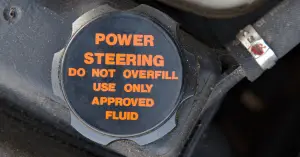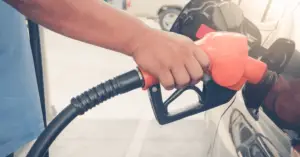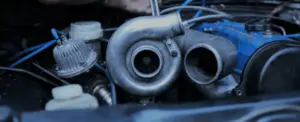
It can be frustrating and worrying to discover a puddle under your car, even more so when you don’t know the source. It is fairly simple to diagnose and fix a power steering fluid leak when the vehicle is running, but it can be more challenging to find the cause if it’s happening when your car isn’t running.
There are several reasons why your power steering fluid might overflow when your car is shut off. These are some of the main causes:
- Overfull tank
- Air bubbles in the tank
- High tank pressure
- Turning the steering wheel after the car is off
- A leak in the reservoir
In this article, we’ll look at each of the causes of power steering fluid overflowing when a vehicle is shut off and discuss how to fix the problem. Let’s get started!
1. Overfilling the Power Steering Fluid Tank
For most cars, you should add power steering fluid while the car’s engine is still hot. If the power steering fluid tank is full when the car has not been running and is cool, the fluid will expand when you turn the car on. When the engine warms up, this will cause the fluid to overflow.
If your power steering fluid overflows when you shut the car off, the tank may be too full. Start by checking your vehicle’s power steering fluid level. Some cars can only be checked after the car has been running for several minutes. Others have lines to mark levels for hot and cold. Some even have a minimum and maximum fluid level and can be checked when the engine is hot or cold.
If your car’s power steering fluid is too high, you can drain the excess fluid to prevent further overflow. The best way to do this is to use a turkey baster or syringe to pull out the extra liquid. This method can be time-consuming, but it works well and doesn’t require mechanical know-how. You can also flush the power steering fluid, but that process is more complicated.
2. Air Bubbles in the Tank
Your vehicle’s power steering fluid may be overflowing because of air pockets trapped in the power steering tank or a hose. The trapped air in the power steering system can form bubbles, and the bubbles push against the power steering fluid when they form, which causes the fluid to rise and overflow.
To fix this problem, you can bleed your power steering system to remove the trapped air. Bleeding your car’s power steering system can also reduce system noise and extend the life of the steering pump. So even if the problem isn’t trapped air, bleeding the system can be beneficial. If you’re ready to tackle this project on your own, check out this how to video.
Keep in mind that there may be a faulty part in your car’s power steering system causing the trapped air. The power steering system is not supposed to allow air in or out, so any trapped air could indicate a bigger problem. If your power steering fluid keeps overflowing, you may need to drain the fluid entirely to find the broken part and replace it.
3. High Tank Pressure
Your car’s power steering fluid may also overflow if the tank’s pressure is too high. A faulty power steering pump can often cause high tank pressure.
The pump controls the pressure of the power steering fluid as it moves through the system. If the pump malfunctions, the pressure can build up and cause the fluid to overflow.
Unfortunately, the only way to fix a faulty pump is to replace it. You can replace your own power steering pump, but some cars require particular tools to do so. Research the power steering system of the make and model of your car before you start this project. Otherwise, take your vehicle to a professional to have them do it.
4. Turning the Steering Wheel After Shutting the Car Off
We are all susceptible to bad driving habits. If your power steering fluid overflows after shutting the car off, think about what you do immediately after you shut your car down. If you have a habit of turning the car off and then turning the steering wheel sharply, you may be causing the power steering fluid to overflow.
This problem has a simple fix – break your bad habit! Try to avoid turning the steering wheel when the car isn’t running. If your power steering fluid continues to overflow, there is likely a bigger issue. Take a look at the rest of our list to narrow down the cause or take your car to a mechanic.
5. Reservoir Leak or Part Malfunction
If your power steering fluid is still overflowing after exploring all of these possibilities, you may need to replace a part of the power steering system. The power steering system has many moving parts, and if one piece is worn out or broken, the overflowing power steering fluid might just be a symptom of a bigger issue.
You might simply have a leak in the power steering fluid reservoir, causing the fluid to leak into other systems. If that’s the case, you can drain the power steering fluid and repair the leak or replace the reservoir. There are also products you can use, like power steering stop leak, that you can pour into the reservoir to stop the leak. However, this is not a permanent solution.
Another part of the system could also be faulty. You may have a clogged hose or a faulty pump, or you may need a belt adjustment. To find the defective part, empty the tank. It’s also a good idea to clean out the cap and the hoses. Gunk in the hoses or other parts of the system can also cause the power steering fluid to overflow. Your system might just need a good cleaning!
If you do have a broken hose, belt, or pump, you can replace these on your own. Bu it may be easier and faster to have a professional fix it for you. You should only attempt your own fixes if you are confident and comfortable working on your vehicle.
Frequently Asked Questions
Can a Power Steering Fluid Overflow Damage My Vehicle?
Yes. If your power steering fluid overflows, the fluid will seep into crevices where it shouldn’t be, including your car’s engine. The excess fluid can cause engine belts to slip or break. It can also hurt the engine itself.
Keep in mind, your car’s engine gets extremely hot while the car is running. Spilled power steering fluid can result in an engine fire. The leaked fluid can also damage other parts, like batteries, and cause them to wear out faster.
Can I Drive My Car With A Power Steering Leak?
If your car’s power steering system is overflowing or leaking, you can drive it briefly, but the leaking power steering fluid will cause problems with your car’s steering and the vehicle will become more dangerous to drive as the problem worsens.
If you suspect that your car has a problem with the power steering system, it is best to address it immediately before the problem damages the rest of the car or the car becomes unsafe to drive.
Is a Power Steering Fluid Overflow Dangerous?
It can be. Power steering fluid is necessary for your power steering to work. If your fluid is regularly overflowing, the system is losing the fluid that it needs. When you lose enough of that fluid, the system may not work as it should.
If your power steering fails while you are driving, you will not be able to turn your steering wheel as easily, and the force you use on the steering wheel will not translate to the tires. This means that you won’t be able to turn as quickly or as sharply, a problem that can very easily cause a traffic accident.
How Much Will It Take to Fix My Power Steering Fluid Problem?
It depends on the problem. A professional flushing or bleeding of the power steering system is not very expensive. However, replacing a part in the system can cost between $500 and $600.
How Can I Prevent Power Steering Problems?
The best way to prevent any car troubles is through regular maintenance. Check your power steering fluid regularly and make sure to change it every 40,000 to 50,000 miles. Keep the system clean and the hoses clear of build-up and gunk.
Of course, you should also have your car inspected regularly. You should also take it to a professional if your power steering system is making odd noises, your steering wheel is heavy or slow to rotate, or if the steering wheel jerks or vibrates. The best way to prevent big problems down the road is to get them looked at while they are still small problems!













